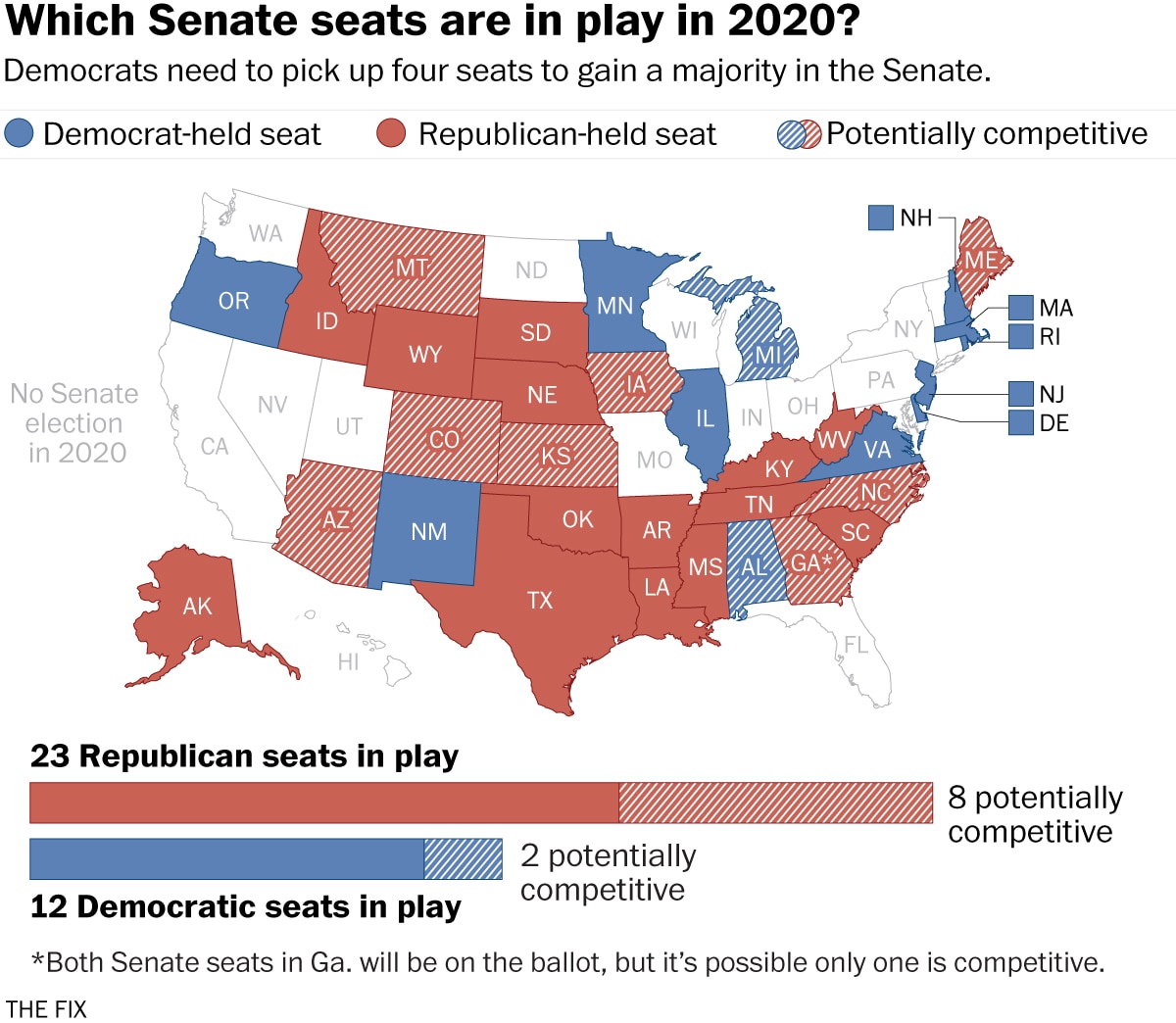How Democrats could win back the Senate, step by step

But Democrats will probably also have to win in at least one state that has traditionally been difficult for them at the Senate level, such as Georgia or Iowa. Let’s review step by step the likeliest paths for how Democrats could win the Senate.
1. Win the White House
Democrats would have an automatic tie-breaking vote in the vice president.
2. Make up for Alabama
Before they can talk about winning more seats, Democrats need to protect their current senators — or at least try. Sen. Doug Jones (D-Ala.) is by far the most vulnerable senator on the ballot in 2020. His unlikely win in 2017 came against a deeply flawed opponent in Roy Moore. Jones will find out later this week or next week whether his Republican opponent will be former attorney general and senator Jeff Sessions or former Auburn University football coach Tommy Tuberville.
When making calculations on where they need to win, operatives on both sides generally assume that Jones will lose. Alabama is one of the most pro-Trump states, and Jones is a Democrat who voted to convict Trump on both impeachment counts.
So Democrats are actually likely to start trying to win the majority while down a seat.
3. Protect Michigan
Sen. Gary Peters (Mich.) is the other potentially vulnerable Democrat in 2020, although he’s not in nearly as much trouble as Jones. I wrote in my recent Senate rankings that his seat could flip in the right conditions for Republicans. And right now, polls show Michigan is leaning toward Joe Biden, the presumptive Democratic presidential nominee, by enough points to help Peters overcome a challenge. But the Republicans’ candidate, John James, an Iraq War veteran and conservative media darling, keeps outraising Peters, so Democrats can’t totally ignore this race.
4. Kick out at least three of these four Republican senators
Cory Gardner (Colo.): Gardner is probably the most vulnerable Republican senator in 2020, given that he’s running for reelection in a state that is rapidly becoming more Democratic, and he has been forced to stick with Trump on a number of issues, including impeachment. He’ll face John Hickenlooper, a popular former governor of the state. Now, Republicans like Gardner are trying not to mention Trump in ads.
Martha McSally (Ariz.): A number of polls show her trailing her Democratic challenger, gun-control activist and former astronaut Mark Kelly. Then, a recent CBS-YouGov poll showed Biden tied with Trump in Arizona, even though Trump won it by 3.5 percentage points in 2016. Other polls have shown Biden ahead in the state.
Thom Tillis (N.C.): Democratic strategists in North Carolina say this state is probably one of the truest toss-ups at the Senate and presidential level. Tillis will face former state senator and Iraq and Afghanistan war veteran Cal Cunningham. Cunningham is consistently outraising Tillis, but it’s looking like a tough race for both of them.
Susan Collins (Maine): Collins is the most entrenched Republican senator on this list. She has won in a purple state for the past 20 years. But after she voted in favor of Trump on some key issues, including on impeachment, Democrats are working hard to damage her independent brand by casting her as more loyal to Trump than to her constituents. They have a strong candidate in Maine House Speaker Sarah Gideon. Collins is formidable, but Democrats probably have their best chance to date of unseating her.
Technically, Democrats could win all four of the toss-up races plus the White House, and then they would have the majority. But that would be an extraordinary performance that would require everything to go right for Democrats. Democrats probably want to expand their chances outside these four main Senate showdowns in case they don’t win them all. And they have, but their final task to the majority is the hardest.
5. Win at least one seat elsewhere
Or more if they don’t win at least three of the toss-up seats above. These final races are in states that either favor Republicans or have Republican senators who are tougher to knock off.
Joni Ernst (Iowa): A recent Des Moines Register poll showed Ernst down three points against Democrat Theresa Greenfield, so unseating Ernst is a possibility in a good election year for Democrats. Especially because Biden is trailing Trump by just one point in Iowa, according to the same poll. Still, it’s always difficult to kick out a sitting Republican senator.
Steve Daines (Mont.): Democrats recruited outgoing Montana governor (and 2020 presidential candidate) Steve Bullock to try to unseat Daines. Montana is a Trump state, but Bullock won reelection in 2016 even as Trump swept it. Trump is expected to win Montana again, and this time Bullock is the challenger rather than the incumbent. A poll released by a Democratic-leaning organization this week shows the race tight, with Bullock leading Daines by two points.
Kelly Loeffler (Ga.): This is actually a special election, because Loeffler was appointed to the seat in December after a retirement. Democrats came close to winning the governor’s mansion in Georgia in 2018 and are hoping they can repeat that performance, and then some, to topple a sitting Republican senator. (The state also looks more competitive at the presidential level for Democrats.) They’ll have to win this Senate seat not in a traditional one-on-one race but in a crowded all-party election where their victory plan relies on Republican candidates taking one another down and then going to a January runoff.
There’s another Senate race in Georgia, too. Sen. David Perdue (R) is running for reelection. Former congressional candidate Jon Ossoff is challenging Perdue, but he hasn’t led Perdue in any major poll.
Democrats’ other options to win back the majority come in even deeper Republican territory, like Kansas, South Carolina and Texas. But their best chances lie in taking the path above.






